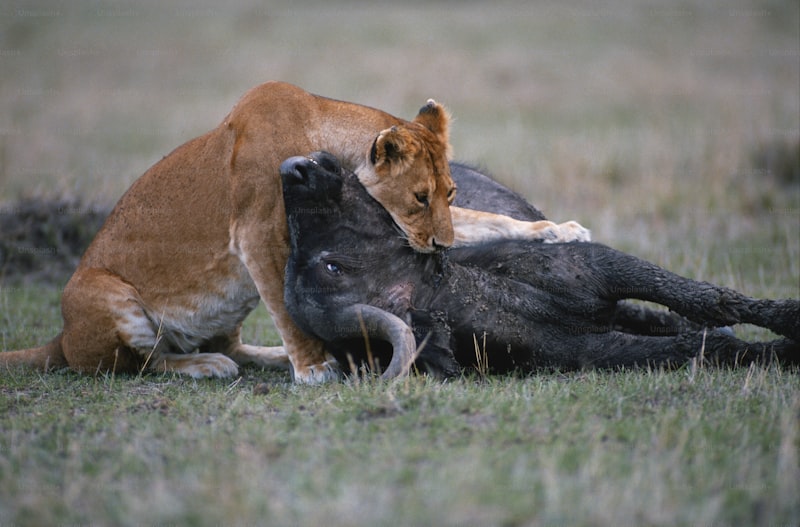Have you ever wondered how carnivores, those apex predators of the animal kingdom, developed their intricate social behaviors? The evolution of social behavior in carnivores is a fascinating tale of adaptation and survival, shaped by millions of years of natural selection.
Carnivores, ranging from lions prowling the savannahs to solitary hunters like the elusive snow leopard, exhibit a wide spectrum of social structures. These behaviors aren’t just random; they are finely tuned mechanisms that aid in their quest for food, reproduction, and protection.
Take lions, for example. They live in prides, where females collaborate to hunt prey while males defend territory. This social structure isn’t just about strength in numbers; it’s a strategy that ensures survival in harsh environments where resources are scarce and competition is fierce.
On the other hand, solitary carnivores like the snow leopard have evolved a different approach. Preferring the solitude of high mountain ranges, these majestic cats maintain vast territories to avoid competition and maximize their chances of encountering prey.
The evolution of these behaviors isn’t solely driven by survival instincts but also by the complexities of social interactions. From pack dynamics in wolves to the intricate communication of hyenas through vocalizations and body language, carnivores have developed sophisticated ways to navigate their social worlds.
But why does this matter? Understanding the evolution of social behavior in carnivores offers insights into broader ecological patterns and conservation efforts. By studying how these behaviors develop and change over time, scientists can better predict how carnivore populations might respond to environmental shifts and human activities.
The evolution of social behavior in carnivores is a testament to the adaptability and complexity of nature. It’s a story of survival strategies honed through millennia, where every roar, scent mark, and hunt plays a crucial role in shaping the intricate tapestry of carnivore societies.
Pack Mentality: Unraveling the Evolutionary Roots of Social Structures in Carnivores
Pack mentality in carnivores is often associated with cooperative hunting and defense strategies. Wolves, for instance, organize themselves into packs led by alpha individuals. This hierarchical structure ensures efficient hunting, with roles ranging from leaders orchestrating hunts to subordinate wolves assisting in chasing and capturing prey.
Similarly, lions form prides, centered around a dominant male and several related females. This social unit not only facilitates successful hunting but also enhances protection of their territory against intruders. The collaborative effort in hunting allows them to tackle larger prey that solitary hunters might find challenging to capture alone.
Beyond hunting, pack mentality fosters social bonds crucial for survival. It promotes cooperation in raising offspring, with older members teaching younger ones essential skills for survival in their ecosystem. This social learning aspect is vital for carnivores, enabling them to adapt to changing environments and challenges over generations.
The evolutionary roots of pack mentality lie in the advantages it offers for carnivores living in competitive and often harsh environments. By forming social groups, individuals increase their chances of survival through collective vigilance, cooperation in resource acquisition, and shared parental care. This adaptability has been honed over millennia, reflecting the intricate balance between individual survival and the collective strength of the pack.
From Solitary Hunters to Group Cohesion: How Carnivores Adapted Socially
Imagine the awe-inspiring sight of a lion pride on the African savannah, working together to bring down a formidable buffalo. This cooperative hunting strategy isn’t just about sharing a meal; it’s a testament to how carnivores have learned to leverage their collective strength. By hunting in groups, these predators increase their chances of making a successful kill while minimizing the risks involved.
Social bonding among carnivores isn’t solely about hunting prowess. It extends to nurturing offspring and defending territories. Wolves, for instance, are renowned for their tight-knit packs led by alpha individuals who organize hunts and maintain order within the group. Each pack member plays a crucial role, whether it’s caring for the young, teaching hunting techniques, or standing guard against potential threats.
The evolution of social behavior in carnivores isn’t confined to land-dwelling species. Marine predators like orcas, also known as killer whales, exhibit highly sophisticated social structures. They live in pods led by matriarchs, where cooperation ensures efficient hunting and protection of their young in vast oceanic environments.
What drives these carnivores to adopt such intricate social dynamics? It’s a blend of survival instincts and adaptation to ecological challenges. In environments where resources are unpredictable, forming social groups allows carnivores to pool their skills and resources for the collective benefit of the group.
From lions on the plains to orcas in the seas, carnivores have evolved from solitary hunters to social strategists. Their ability to form cohesive groups underscores the importance of social bonds in the animal kingdom, offering insights into evolutionary biology and the delicate balance of ecosystems.
The Social Dynamics of Carnivores: Insights into Cooperative Hunting and Group Living
Cooperative hunting stands out as a hallmark of carnivore social behavior. Unlike solitary hunters, carnivores such as African wild dogs employ teamwork to bring down prey much larger than themselves. This strategy not only increases their hunting efficiency but also strengthens social bonds within the pack. Each member has a defined role: some chase the prey while others wait to ambush, showcasing a sophisticated division of labor akin to a well-coordinated team.
Group living among carnivores offers numerous benefits. It provides protection against predators, enhances hunting success through collective effort, and facilitates the raising of offspring through communal care. In wolf packs, for instance, the alpha pair leads the group, ensuring order and discipline while subordinate members contribute to the pack’s survival. This social structure promotes cohesion and ensures the group’s resilience in challenging environments.
Social hierarchies play a crucial role in carnivore communities. Dominance within the pack determines access to resources such as food and mating opportunities. In spotted hyenas, the social hierarchy is matriarchal, with females holding higher status than males. This unique arrangement reflects adaptive strategies shaped by evolutionary pressures and ensures efficient resource allocation within the group.
Communication is another vital aspect of carnivore social dynamics. Vocalizations, body language, and scent marking convey information essential for maintaining group cohesion and coordinating activities like hunting and territory defense. For example, cheetahs use a variety of vocalizations to communicate with each other over long distances, facilitating effective cooperation during hunts.

Studying the social dynamics of carnivores offers valuable insights into how these animals navigate their environments and thrive through cooperation and structured group living. By understanding these behaviors, researchers gain deeper appreciation for the complexity of carnivore societies and the evolutionary strategies that have shaped their survival over millennia.
Survival of the Friendliest: Evolutionary Advantages of Social Behavior in Carnivorous Species
Imagine a pride of lions hunting together on the African savannah. Each member has a role: some stalk prey while others flank or ambush. This division of labor isn’t just efficient; it’s crucial for their success in catching prey that can outrun any single lion. By working together, they increase their chances of a successful hunt, ensuring a meal not just for one, but for the entire pride.
Similarly, wolves exhibit complex social structures known as packs. These packs aren’t just familial—they’re strategic units that support each other through hunting, defending territory, and raising young. By forming packs, wolves can tackle larger prey, defend against competitors, and adapt to changing environments more effectively than solitary animals.
Even in the insect world, social behavior plays a vital role. Take ants, for example. They live in colonies where each member has a specific role: workers gather food, soldiers defend the nest, and the queen reproduces. This division of labor ensures the colony’s survival and growth, allowing ants to thrive across diverse habitats from forests to deserts.
But why does social behavior persist in carnivorous species despite the risks of competition and conflict? The answer lies in the benefits of cooperation. By working together, these animals increase their chances of survival, reproduction, and overall success in their ecosystems. Social groups provide protection from predators, access to resources, and opportunities for learning and innovation.
In essence, while carnivores are known for their prowess as hunters, their ability to form social bonds and cooperate with others—be it within prides, packs, or colonies—gives them a competitive edge in the struggle for survival. Evolution has favored those who can navigate the complexities of social interaction, turning the concept of “survival of the fittest” into “survival of the friendliest” for these remarkable carnivorous species.
Secrets of Cooperation: How Social Bonds Shaped Carnivore Societies Over Millennia

Have you ever wondered how carnivores like lions, wolves, and hyenas manage to live together in packs so seamlessly? The secrets lie in the intricate web of social bonds that have evolved over millennia, shaping their societies in fascinating ways.
In the animal kingdom, cooperation isn’t just about survival—it’s about thriving together. Take lions, for example. These majestic predators form prides where females collaborate to hunt prey while males defend the territory. This division of labor isn’t just efficient; it’s a testament to the power of social bonds. By working together, lions increase their hunting success and ensure the survival of their young.
Wolves, on the other hand, exhibit remarkable teamwork through their pack structure. Each wolf has a role, whether it’s hunting, caring for pups, or defending the pack. This cooperative behavior isn’t innate but learned and reinforced through social interactions. Through intricate communication and hierarchical structures, wolves exemplify how social bonds are essential for their survival in the wild.
Hyenas, often misunderstood, showcase one of the most complex social structures among carnivores. Living in matriarchal clans, hyenas cooperate to raise young, hunt large prey, and defend their territories. Their societies are built on trust and reciprocity, where individuals rely on each other’s strengths to thrive in challenging environments.
What’s fascinating is how these social bonds have evolved over millennia. Through natural selection, carnivores have honed their cooperative behaviors to maximize their chances of survival. It’s a delicate balance of competition and collaboration, where each member plays a crucial role in the group’s success.
In the Shadows: Nocturnal Social Strategies Among Carnivores Revealed
Among these nocturnal predators, stealth and strategy reign supreme. Imagine the majestic lioness, orchestrating a silent hunt under the cloak of darkness, communicating through subtle cues and gestures with her pride. Each member plays a crucial role, from the initial stalk to the final coordinated ambush, demonstrating an intricate social structure built on trust and cooperation.
Similarly, the elusive jaguar, a solitary wanderer by day, transforms into a ghostly predator by night. Its solitary nature belies a complex social fabric woven through scent markings and vocalizations, allowing it to navigate a territory rife with competition and danger.
For wolves, the cover of night is not just a shield but a canvas for their communal existence. Their howls resonate through the wilderness, serving as both a rallying call and a territorial declaration. Pack hierarchy dictates roles during the nocturnal hunt, where each member contributes to the group’s survival, reinforcing bonds through shared meals and intricate social rituals.
Beyond the charismatic megafauna, smaller carnivores like foxes and raccoons also embrace nocturnal living. Their social interactions, though less pronounced, revolve around resource sharing and avoiding larger predators. Through scavenging and opportunistic hunting, these creatures navigate a nocturnal world teeming with challenges and opportunities.
Frequently Asked Questions
What factors influence the development of social behavior in carnivores
Factors influencing social behavior development in carnivores, including genetics, environmental conditions, social structure, and early life experiences.
What social behaviors do carnivores exhibit
This FAQ description provides concise information on the social behaviors exhibited by carnivores. It focuses on describing the various social interactions and behaviors observed in carnivorous animals, including pack hunting, social hierarchies, and cooperative behaviors within their groups.
What are the evolutionary benefits of social behavior in carnivores
Discover how social behavior in carnivores, such as cooperative hunting and group defense, enhances survival through improved hunting success, better care for young, and protection against predators. Social bonds also promote resource sharing and increase overall fitness within the group.
How do carnivores communicate within their social groups
Learn how carnivores communicate within their social groups, exploring behaviors such as vocalizations, body language, and scent marking that play crucial roles in maintaining group cohesion and hierarchy.
How do social structures vary among carnivore species
Learn about the diverse social structures among carnivore species, exploring how they vary based on factors like hunting strategies, prey availability, and group dynamics. Gain insights into the evolutionary adaptations that shape their social behaviors and survival strategies.


